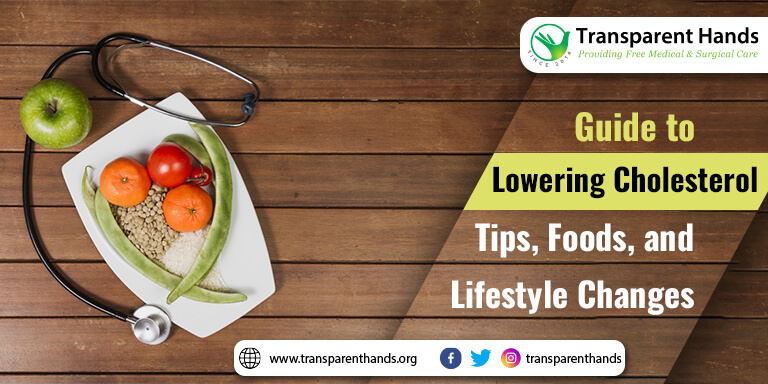Guide to Lowering Cholesterol: Tips, Foods, and Lifestyle Changes

Cholesterol is a waxy substance found in all cells of the body. The chemical is essential for many bodily functions, including transporting vitamins, producing hormones, and most importantly building cell membranes. However, too much cholesterol can be harmful to your health.
Cholesterol and heart disease go hand in hand, and to mitigate the risks caused by it in this article, we will explore the two types of cholesterol, which is good for you and which is bad, and how to balance the two to improve your quality of life
What are the different types of cholesterol?
There are two main types of cholesterol: low-density lipoprotein (LDL) cholesterol and high-density lipoprotein (HDL) cholesterol. Understanding LDL and HDL cholesterol is important because of the common misconception that all cholesterol is bad.
LDL cholesterol is often called “bad” cholesterol because it can build up in your arteries and form plaques. This can lead to atherosclerosis, a condition that narrows your arteries and increases your risk of heart disease and stroke.
HDL cholesterol is often called “good” cholesterol because it helps to remove LDL cholesterol from your arteries. HDL cholesterol carries LDL cholesterol back to your liver, where it is broken down and excreted from your body.
How much cholesterol do you need?
The amount of cholesterol you need depends on several factors, including your age, sex, and overall health. However, most adults should have an LDL cholesterol level below 130 milligrams per deciliter (mg/dL) and an HDL aka healthy cholesterol level above 40 mg/dL.
Increased cholesterol levels significantly increase the risk of heart-related diseases. While medicine may be a quick fix for it, here are 4 cholesterol management tips that can help bring your cholesterol levels down.
Embrace a Heart-Healthy Diet
A heart-healthy and low-cholesterol diet plan takes priority when looking for natural ways to reduce cholesterol. The diet comprises foods that regulate various levels of bad fats we intake. First and foremost, the intake of saturated fats should be decreased. These fats are solid at room temperature and are commonly found in full-fat dairy items, red meat, and certain processed foods. Consuming them in excess can cause the body to produce more cholesterol than normal and increase the risk of heart disease and stroke.
It is important to note that not all saturated fats are bad, as some have health benefits too. But, it is recommended to limit its intake as a part of a well-balanced diet.
Trans fats are the unhealthiest form of fat for health. They are mainly present in processed, baked, and fried foods and snacks. They increase LDL cholesterol and apart from increasing the risk of heart disease can cause other health problems such as inflammation and diabetes too.
To combat the effects of bad fats and cholesterol, there are multiple cholesterol-lowering foods. Foods rich in omega-3 fatty acids lower blood pressure and enhance heart health. Sources include fatty fish like salmon, mackerel, and herring, as well as walnuts and flaxseeds.
Increasing the consumption of soluble fiber can help reduce the absorption of cholesterol in your bloodstream. Soluble fiber-rich foods include legumes, oats, vegetables, and fruits. Similarly, whey protein (found in milk, cheese, and yogurt) can also aid in lowering total cholesterol, LDL cholesterol, and blood pressure.
Increasing physical activity
Exercise for most of the week can help regulate cholesterol levels inside the body and even increase HDL (the good cholesterol). Doctors recommend exercising moderately for 30 minutes a day, five times a week, or doing a cardio-intensive activity for 20 minutes, 3 times a week.
If taking out dedicated time for exercising is tough, adding physical activities in short bursts throughout the day can help as well.
These activities include:
- Going for a short walk during lunch break
- Playing a sport
- Cycling to work
To stay motivated one can track their progress, and view weekly or monthly progress.
Quit smoking
Quitting smoking has a direct impact on cholesterol, so much so that within 20 minutes of quitting, the heart rate and blood pressure recover from a cigarette-induced spike.
After 3 months of quitting the lung function and blood circulation begin to improve and within a year the risk of heart disease is half that of a smoker. Quitting also impacts HDL cholesterol levels and improves them.
Lose weight
Being overweight significantly impacts cholesterol levels and increases them. Fitness is a journey and even small steps such as cutting out unhealthy snacking and limiting eating hours contribute to weight loss.
A few tips to keep in mind are:
- Cutting sugary drinks
- Explore intermittent fasting
- Increase water intake
- Cutting fried items
- Cutting junk/fast food
- Incorporate as much physical activity as you can
- Use the stairs instead of the elevator
- Take frequent walk breaks during work
Conclusion:
If dietary and lifestyle changes aren’t sufficient to lower cholesterol levels, it is important to consult a doctor and explore viable cholesterol medication options before taking anything. Medication needs to be taken as a last resort and only after consulting with a physician.
But first, it is important to follow cholesterol screening guidelines to see what steps need to be taken.
Must Read:










Leave a Reply